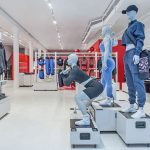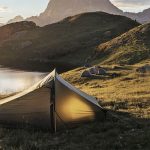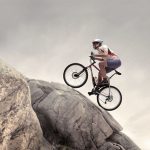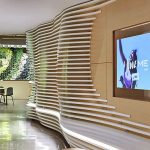As always, the SIA show floor seemed the meeting of the frathouse and the country club as the rather quiet ski end abutted the boisterous snowboard section. The tag line for the show was One Family. One House., but there was definitely more energy – and noise – coming from the kids table. Twin-tip companies like Line and 4FRNT created party oases in the ski section, but for the most part things seemed quiet in that part of showfloor, at least when compared to the noise of the snowboard half of the venue.
Reports on the floor had goggle companies doing well with sell-through at retail as consumers looked to update their look without necessarily breaking the bank. Otherwise, retail seemed to be clearing out its inventory after last year, though the heavy snow in December and early January that blanketed much of the country definitely created an up-beat mood on the show floor.
The novelty of twin-tip skis has worn off with the category now on its way to maturity. The question now will simply be one of finding stasis for how much of the product the market can bear. Traditional skis continue to move towards a fatter base and bindings are now being redesigned to accommodate the wider platforms. Mainstream ski apparel is cleaner and simpler than in past seasons. Technical features are still important, but many are now hidden, making for more streamlined silhouettes. Comfort is an ongoing focus in ski boots, with many vendors now offering models with heat-moldable linings, memory foams, and microfleece linings.
Two major buzzwords floated across the ski/snowboard divide: collaboration and eco-conscious. For collaboration, artist collaborations are on the rise in both hardgoods and softgoods. These initiatives create buzz and they help turn ordinary products into highly sought collectors items. Taking the form of everything from graphics on skis and snowboards to apparel designs, the collaborations even work between companies, especially on the snowboard front. As far as the greening of the show floor, the movement has been happening for a few years now, but this show saw more companies coming to the understanding that eco-conscious is borne in the process and not just in the end result. A quick example is those companies using bamboo are quick to point out that they make sure their suppliers use eco-friendly means of delivering the product.
In snowboard hardgoods, the anti-camber design spread like wildfire across the show floor with nearly every company offering at least one board rounded on the bottom. The logic behind the design change from traditional boards ranged from building a board that gave more float when in powder to a board that carves like a knife through butter, but regardless this was definitely the direction the floor was taking. In bindings, the toe box got a bit more focus this year than it had seen since the convertible front strap was first introduced with a couple of unique designs an end result.
There was 80s retro beginning to creep into grunge, collaborations with artists and other brands, and a profusion of denim as the most common stories in snowboard apparel on the show floor, except of course for the eco movement and the color purple. BOA Technology continues to have its presence felt in a major way in the boot category, though more and more companies continue to either refine that technology in cooperation with the company or try to find their own personal work-around. New technologies were more of an evolution here than anything revolutionary. While the 80s retro brightness popped up in a couple boots in everyones line, black, white and gray are still the likely big sellers.
A snapshot of the hadgoods business:
K2 Ski added to its all-mountain Apache ski series with the Xplorer, which features the Marker MX binding system that boasts wider contact points to accommodate the wider ski. The Burnin Luv, part of the womens T:Nine line, received a new shape and construction, as well as a new sidewall, for Winter 2008/09.
Line attended its first SIA show under K2/Jarden ownership. According to Line founder Jason Leventhal, the company doubled its sales from last year, and expects to double sales again next year. He also noted that Line skis are developed separately from K2s offerings, thus allowing Line to focus on its originality and quality. “What used to be crazy wide is not the norm in the industry, and twin tips are fully accepted,” said Leventhal. “Line was ahead of its time, and now the industry is catching up.”
Full Tilt, another K2-owned company, which has earned a cult following, continued to offer a small, focused line of three-piece ski boots. Bellowed tongues offer plenty of forward flex, and Intuition liners add comfort. Cool colors, new flex patterns, and a womens-specific boot rounded out the five-model line for Winter 2008/09.
Tecnica boasted three initiatives in its Winter 2008/09 ski boot offerings. First is improved fit, accomplished with new liner materials and constructions throughout the line. Second is the new Dragon Series (comprised of one womens model and three mens models) that offers consumer-friendly “simplistic performance” via a more comfortable, upright stance than the Diablo high-end race boot collection. Third is a new AT boot in the Agent freeride line, the Agent AT, designed for all-mountain use.
According to Geoff Curtis, VP of marketing at Marker/Volkl USA, “The proliferation of wider skis is leading to new binding designs to enhance ride and handling.” He also pointed to a distinct skate influence in Volkls (and other companies) freeride skis, noting, “Skis with reverse camber are easier to use on groomed snow, and the rocker design makes the ski easier to maneuver in deep snow.” Volkl has also expanded its womens freeski line, because, said Curtis, “Adding more selection to the category will help boost sales at retail.”
Rome SDS launched its first outerwear line for next season with the crowded back booth suggesting retailers were responding well. The line features two collections, Manifest, which draws inspiration from art and streetwear, and 100, which is for a more typical snowboarder look.
DC, celebrating its 10th anniversary, launched snowboards at the show with retailer reception described as “fantastic.” On the tech side, the boards feature Radius to Flat construction on the tip and tail that creates the same amount of lift in powder on a shorter board. In boots, DC introduced the Rapid Lacing System that mimics Boa-style technology, but at a lower price point.
K2 Snowboards also tapped into the new board shape, expanding its Rocker series from a board designed for powder riding to include two additional shapes, one specifically for women and the other for all-terrain riding. K2 also introduced Harshmellow technology, which is a three layer cushioning system across board, binding and boot. The Harshmellow system is included as part of the companys Ø board, which also features K2s Hybrilight Construction that uses minimal amounts of materials in construction and a Tek-Style topsheet that eliminates the need for UV coating.
i.e. distribution had a crowded booth as it grows its business through both new products and new brands. The company is establishing a good-better-best strategy with the use of its Airwalk licensed business topped by World Industries and a newest World Industries Gold Series that is at the highest end. Company President John Dickinson said i.e. had the #1 winter ski at Forzani, but expects the new Moto helmet to be a big seller for the season ahead as more kids are now wearing a full-face helmet than before.
Flow continues to see its boards and boots business grow, though its bread and butter remains bindings with its unique easy-in, easy-out, Reclining Hiback system. In its team binding, the company switched from a carbon fiber hiback to dynalite to allow new colorways, while also reducing the chance of chipping. Additionally, the company redesigned the ratchet system on its bindings with larger tabs and a unique pull-out, locking mechanism that reduces worry of the ladder strap coming loose.
Signal Snowboards, out of the Pacific Northwest, looked to the eco-trend by reducing the amount of waste created by manufacturing snowboards. The company merged with the factory that had previously produced its boards, Five Axis, over the summer to be able to take total control over the process. Its OG boards feature hand painted top sheets, with a base that is made of recycled base materials as part of the Flotsam & Jetsam Project.
Arbor was one of a handful of companies utilizing StrucTurn, a base technology that helps move water along, creating a quicker riding board, especially in wet conditions. The company also had a pair of collaboration boards with Rogue Status and worked with the Price Collection to recreate Edo Period silk scrolls as snowboard topsheets. The big story for Arbor, though, remains its focus on sustainable technologies, with a heavy focus on bamboo.
Stepchild featured the anti-camber board shape seen across the floor, but also introduced RETT or round edge tapered tuning on several models, a technique that stemmed from the companys team riders. Rather than having a sharp edge for the length of the board, the edges are sharp at the contact points on the tip and tail, but gradually taper to a rounded tune in the boards middle, which helps prevent catching on rails when grinding in the park. This new construction technique is featured on the companys Jib Stick board.
Ride continues to push the limits with its bindings, introducing the Contra Band binding. With a traditional, adjustable strap across the top of the foot and a unique, Y-shaped strap that runs from the big toe to the adjustable strap, the Contra Band is one of the most unique designs since Flows Reclining Hiback. The market will ultimately decide the feasibility of the new design, but it should at least help to create some innovation here. Ride also launched a custom boot build program that allows the manufacturer to ship boots up to size 22, following numerous requests for sizes larger than 16. The special order boots will be distributed out of Seattle-based retailer, Evo.
Pro-Tec now offers seven womens-specific helmets, and is launching the Vigilante helmet that features Boa adjustment. Pro-Tecs top-end padded base layers offer heat-sensitive memory foam that is heat-sealed into the garments to eliminate seams.
K2 Ski helmets in the Winter 2008/09 line include audio pads, and the company is now launching the Indie, a low-profile hardshell model.
Electric Visual saw Santa descend on its booth at the show, though rumors that he had something to do with Volcom could not be independently confirmed. A spokesman for Electric said the acquisition was a perfect fit for Electric, but that both companies would continue to operate as separate entities. The companys EG2 oversized goggle enters its second year with new colorways. The goggle had already sold out at retail by new year with a limited edition run used as a means of keeping inventory in stock and fresh.
Dragon introduced a new goggle, The Rogue, with a limited edition that featured artwork by Jamie Lynn, who recently reunited with the brand. Gigi Rufs signature model took a tip from the Simpsons to create a very unique looking goggle. Dragon is focusing on creating a total package around the special editions, with matching goggle bags and packaging.
Spy hopes to see strong sales for 2008/2009 by focusing on introducing new technologies, particularly the Mosaic lens found on its Apollo goggle. The lens features a dual radius construction with a wrap around fit, effectively giving a large field of vision without having to construct an extremely oversized goggle.















